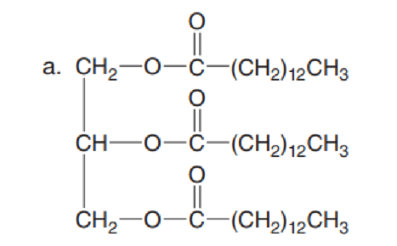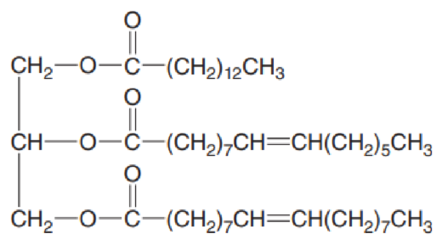
Connect 1-Semester Online Access for Principles of General, Organic & Biochemistry
2nd Edition
ISBN: 9780077633707
Author: Janice Smith
Publisher: Mcgraw-hill Higher Education (us)
expand_more
expand_more
format_list_bulleted
Concept explainers
Textbook Question
Chapter 15.5, Problem 15.11P
Draw the products formed from hydrolysis of each triacylglycerol.
- a.

- b.

Expert Solution & Answer
Want to see the full answer?
Check out a sample textbook solution
Students have asked these similar questions
Using Benzene as starting materid show
how each of the Following molecules Contel
Ve syntheswed
CHI
9.
b
-50311
с
CHY
503H
Ночто
d.
อ
•NOV
e
11-0-650
NO2
The molecule PYRIDINE,
6th electrons and is therefore aromatre
and is Assigned the Following structure
contering
Since aromatk moleculoy undergo electrophilic
anomatic substitution, Pyridine shodd undergo
The Following reaction
+ HNO3
12504
a. write all of the possible Mononitration Products
that could Result From this reaction
18. Bared upon the reaction mechanison determime
which of these producty would be the major
Product of the hegetion
a. Explain Why electron withdrawing groups
tend to be meta-Directors. Your answer Should
lyclude all apropriate. Resonance contributing
Structures
fo. Explain why -ll is an outho -tura
drccton even though chlorine has a very High
Electronegativity
Chapter 15 Solutions
Connect 1-Semester Online Access for Principles of General, Organic & Biochemistry
Ch. 15.1 - In which solvents or solutions will a lipid be...Ch. 15.2 - (a) Draw a skeletal structure for each fatty acid....Ch. 15.2 - Prob. 15.3PCh. 15.2 - Prob. 15.4PCh. 15.3 - Draw the structure of a wax formed from stearic...Ch. 15.3 - One component of jojoba oil is a wax formed from...Ch. 15.3 - What hydrolysis products are formed when cetyl...Ch. 15.4 - Draw the structure of a triacylglycerol that...Ch. 15.4 - Prob. 15.9PCh. 15.4 - Draw the structure of a triacylglycerol that fits...
Ch. 15.5 - Draw the products formed from hydrolysis of each...Ch. 15.5 - Prob. 15.12PCh. 15.6 - Draw the structure of two different cephalins...Ch. 15.6 - Classify each lipid as a triacylglycerol,...Ch. 15.7 - Why are phospholipids rather than triacylglycerols...Ch. 15.7 - Prob. 15.16PCh. 15.8 - Prob. 15.17PCh. 15.8 - Prob. 15.18PCh. 15.9 - Prob. 15.19PCh. 15.9 - Prob. 15.20PCh. 15.10 - Why is it much easier to overdose on a fat-soluble...Ch. 15.10 - Prob. 15.22PCh. 15 - Prob. 15.23UKCCh. 15 - Prob. 15.24UKCCh. 15 - Prob. 15.25UKCCh. 15 - What hydrolysis products are formed when the wax...Ch. 15 - Prob. 15.27UKCCh. 15 - Prob. 15.28UKCCh. 15 - Draw the products formed when the given...Ch. 15 - Prob. 15.30UKCCh. 15 - Prob. 15.31UKCCh. 15 - Prob. 15.32UKCCh. 15 - Prob. 15.33APCh. 15 - Label each compound as a hydrolyzable or...Ch. 15 - Prob. 15.35APCh. 15 - Prob. 15.36APCh. 15 - Prob. 15.37APCh. 15 - How does each of the following affect the melting...Ch. 15 - Rank the fatty acids in order of increasing...Ch. 15 - How would you expect the melting points of the...Ch. 15 - Prob. 15.41APCh. 15 - Why are soaps water soluble, but the fatty acids...Ch. 15 - Draw the structure of a wax formed from palmitic...Ch. 15 - Prob. 15.44APCh. 15 - Prob. 15.45APCh. 15 - Prob. 15.46APCh. 15 - Prob. 15.47APCh. 15 - What hydrolysis products are formed when each wax...Ch. 15 - Draw a triacylglycerol that fits each description:...Ch. 15 - Draw a triacylglycerol that fits each description:...Ch. 15 - Prob. 15.51APCh. 15 - Prob. 15.52APCh. 15 - Prob. 15.53APCh. 15 - Prob. 15.54APCh. 15 - Prob. 15.55APCh. 15 - Draw the products formed when the given...Ch. 15 - Prob. 15.57APCh. 15 - Prob. 15.58APCh. 15 - Prob. 15.59APCh. 15 - Prob. 15.60APCh. 15 - Prob. 15.61APCh. 15 - Why are LDLs soluble in the blood?Ch. 15 - Describe the role of HDLs and LDLs in cholesterol...Ch. 15 - Prob. 15.64APCh. 15 - Prob. 15.65APCh. 15 - Prob. 15.66APCh. 15 - Answer each question with regards to vitamins A...Ch. 15 - Answer each question in Problem 15.67 for vitamins...Ch. 15 - Prob. 15.69APCh. 15 - Prob. 15.70APCh. 15 - Prob. 15.71APCh. 15 - How are soaps and phosphoacylglycerols similar in...Ch. 15 - Some fish oils contain triacylglycerols formed...Ch. 15 - Some marine plankton contain triacylglycerols...Ch. 15 - Prob. 15.75APCh. 15 - Prob. 15.76APCh. 15 - Prob. 15.77APCh. 15 - Prob. 15.78APCh. 15 - Prob. 15.79CPCh. 15 - Prob. 15.80CP
Knowledge Booster
Learn more about
Need a deep-dive on the concept behind this application? Look no further. Learn more about this topic, chemistry and related others by exploring similar questions and additional content below.Similar questions
- 9. Write Me product as well as the reaction Mechanism For each of the Following Vanctions +H₂504 4.50+ T C. +212 Fellz 237 b. Praw the potential energy Diagrams For each OF Mese Rauctions and account For any differences that appear in the two potential Puergy Diagrams which of here two reactions 19 Found to be Reversable, Rationalice your answer based upon the venation mechanisms and the potential energy diagrams.arrow_forward9. Write Me product as well as the reaction Mechanism For each of the Following Veritious +H2504 4.50+ + 1/₂ Felly ◎+ 7 b. Praw he potential energy Diagrams For each OF Mese Ronctions and account for any differences that appeak in the two potential Puergy Diagramsarrow_forwardDraw the major product of this reaction. Ignore inorganic byproducts. Incorrect, 3 attempts remaining 1. excess Br2, NaOH 2. neutralizing workup Qarrow_forward
- Given the electrode Pt | Ag | Ag+ (aq), describe it.arrow_forwardAt 25°C, the reaction Zn2+ + 2e ⇄ Zn has a normal equilibrium potential versus the saturated calomel electrode of -1.0048 V. Determine the normal equilibrium potential of Zn versus the hydrogen electrode.Data: The calomel electrode potential is E° = 0.2420 V versus the normal hydrogen electrode.arrow_forwardElectrochemistry. State the difference between E and E0.arrow_forward
- In an electrolytic cell, the positive pole is always assumed to be on the right side of the battery notation. Is that correct?arrow_forwardIn an electrolytic cell, the positive pole is always assumed to be on the right side of the battery. Is that correct?arrow_forwardCalculate the free energy of formation of 1 mol of Cu in cells where the electrolyte is 1 mol dm-3 Cu2+ in sulfate solution, pH 0. E° for the Cu2+/Cu pair in this medium is +142 mV versus ENH.Assume the anodic reaction is oxygen evolution.Data: EH2 = -0.059 pH (V) and EO2 = 1.230 - 0.059 pH (V); 2.3RT/F = 0.059 Varrow_forward
- If the normal potential for the Fe(III)/Fe(II) pair in acid at zero pH is 524 mV Hg/Hg2Cl2 . The potential of the saturated calomel reference electrode is +246 mV versus the NHE. Calculate E0 vs NHE.arrow_forwardGiven the galvanic cell whose scheme is: (-) Zn/Zn2+ ⋮⋮ Ag+/Ag (+). If we know the normal potentials E°(Zn2+/Zn) = -0.76V and E°(Ag+/Ag) = 0.799 V. Indicate the electrodes that are the anode and the cathode and calculate the E0battery.arrow_forwardIndicate the functions that salt bridges have in batteries.arrow_forward
arrow_back_ios
SEE MORE QUESTIONS
arrow_forward_ios
Recommended textbooks for you
 Chemistry for Today: General, Organic, and Bioche...ChemistryISBN:9781305960060Author:Spencer L. Seager, Michael R. Slabaugh, Maren S. HansenPublisher:Cengage Learning
Chemistry for Today: General, Organic, and Bioche...ChemistryISBN:9781305960060Author:Spencer L. Seager, Michael R. Slabaugh, Maren S. HansenPublisher:Cengage Learning Introduction to General, Organic and BiochemistryChemistryISBN:9781285869759Author:Frederick A. Bettelheim, William H. Brown, Mary K. Campbell, Shawn O. Farrell, Omar TorresPublisher:Cengage Learning
Introduction to General, Organic and BiochemistryChemistryISBN:9781285869759Author:Frederick A. Bettelheim, William H. Brown, Mary K. Campbell, Shawn O. Farrell, Omar TorresPublisher:Cengage Learning
 Chemistry: Matter and ChangeChemistryISBN:9780078746376Author:Dinah Zike, Laurel Dingrando, Nicholas Hainen, Cheryl WistromPublisher:Glencoe/McGraw-Hill School Pub Co
Chemistry: Matter and ChangeChemistryISBN:9780078746376Author:Dinah Zike, Laurel Dingrando, Nicholas Hainen, Cheryl WistromPublisher:Glencoe/McGraw-Hill School Pub Co

Chemistry for Today: General, Organic, and Bioche...
Chemistry
ISBN:9781305960060
Author:Spencer L. Seager, Michael R. Slabaugh, Maren S. Hansen
Publisher:Cengage Learning


Introduction to General, Organic and Biochemistry
Chemistry
ISBN:9781285869759
Author:Frederick A. Bettelheim, William H. Brown, Mary K. Campbell, Shawn O. Farrell, Omar Torres
Publisher:Cengage Learning



Chemistry: Matter and Change
Chemistry
ISBN:9780078746376
Author:Dinah Zike, Laurel Dingrando, Nicholas Hainen, Cheryl Wistrom
Publisher:Glencoe/McGraw-Hill School Pub Co
Lipids - Fatty Acids, Triglycerides, Phospholipids, Terpenes, Waxes, Eicosanoids; Author: The Organic Chemistry Tutor;https://www.youtube.com/watch?v=7dmoH5dAvpY;License: Standard YouTube License, CC-BY